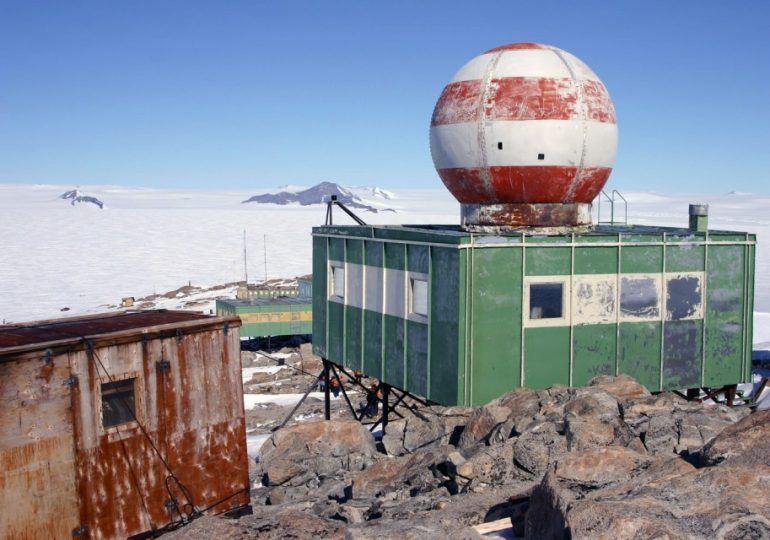PERCHED atop a windy cliff in Antarctica, surrounded by nothing but ice for thousands of miles, lies the ghost of a once-bustling Soviet outpost.
Leningradskaya Station, once the frosty home to USSR boffins, now stands as a testament to a time when human ambition knew no bounds, even in the most unforgiving of environments.
mikeusherphotography.comThe radar dome at the abandoned research base[/caption]
Victor PomelovThe Leningradskaya Station is an abandoned Soviet research outpost[/caption]
Peter ClearyThe station now is nothing more than metal buildings left to rot atop a cliff[/caption]
Digital Photography Review / King_penguinVehicles once used by researchers can also be seen scattered around the snow[/caption]
The year was 1971, and the world was deep in the throes of the Cold War.
Far from the eyes of the public and the concerns of everyday life, the Soviet Union had its sights set on a new frontier — Antarctica.
Here, amidst the endless white, the Soviets established Leningradskaya station, named after one of their most historic cities, Leningrad.
The station was built on the icy plains of Queen Mary Land, a remote and desolate part of the continent.
It was a place where the temperature could drop below -50°C, where the wind howled relentlessly, and where the sun disappeared for months during the long, dark winter.
But for the Soviets, Leningradskaya was more than just a research station.
It was a symbol of their scientific might and a strategic foothold in the southernmost reaches of the Earth.
LIFE ON THE WORLD’S EDGE
The scientists and engineers who lived at Leningradskaya were a hardy breed.
They arrived each summer, ferried by ships that broke through the thick sea ice, bringing supplies for the months ahead.
As the austral summer sun hovered low on the horizon, the station buzzed with activity.
Meteorologists, glaciologists, and geophysicists worked side by side, gathering data that would contribute to our understanding of Earth’s climate and the mysterious forces at play in the polar regions.
Inside the station’s prefabricated buildings, life was a careful balance of routine and survival.
The buildings, designed to withstand the harsh Antarctic conditions, were connected by walkways to protect the inhabitants from the biting winds.
Scientists worked in their labs, analysing ice cores, measuring geomagnetic fields, and studying the atmospheric patterns that swirled above the icy continent.
In their free time, they played chess, read books, and wrote letters home, knowing it would be months before any reply could reach them.
But as the 1980s drew to a close, the Soviet Union began to crumble.
The once-mighty empire was buckling under the weight of economic strain and political unrest.
The stations in Antarctica, far from the eyes of the Kremlin and costly to maintain, were slowly abandoned.
And Leningradskaya was no exception.
THE LONG SILENCE
In 1991, as the Soviet Union took its last breath, the doors of Leningradskaya were closed for what seemed like the final time.
The last group of scientists boarded the ship that would take them back to a country in turmoil, leaving behind a station that would soon be consumed by the cold and silence of Antarctica.
For years, Leningradskaya stood alone against the elements, its buildings slowly being buried under snowdrifts, its windows frosted over, and its halls echoing with the memories of those who once lived and worked there.
The station, once a hub of scientific activity, became a ghost town, a relic of a bygone era.
A FROZEN TIME CAPSULE
Today, Leningradskaya remains as it was left, a frozen time capsule in the heart of Antarctica.
The station’s structures, weathered by decades of exposure to the elements, still stand, though they are slowly succumbing to the relentless forces of nature.
Inside, old equipment lies dormant, and the footprints of the last scientists are preserved in the snow that has drifted in through broken doors and windows.
Occasionally, a team of researchers might visit, drawn by the station’s history or by the desire to recover data from the instruments left behind.
But for the most part, Leningradskaya is left to its solitude, a quiet monument to human determination and the relentless passage of time.
And as the wind continues to howl across the ice, Leningradskaya stands as a ghostly sentinel, guarding the secrets of the past in one of the most remote places on Earth.
WikipediaAntarctica is found on the bottom of the globe[/caption]
Leave a comment








